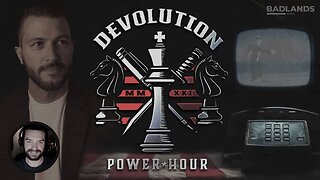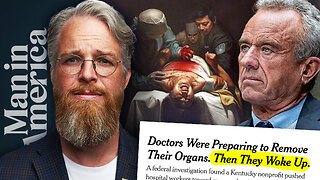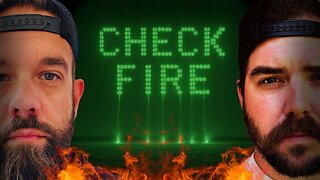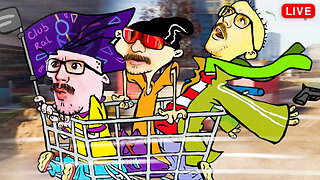Premium Only Content

The Spirit Of Radio Red Barchetta Rush
The Spirit Of Radio Track 1
Red Barchetta Track 2 Album: Exit... Stage Left (1981)
by Rush
Exit... Stage Left is the second live album by the Canadian rock band Rush, released as a double album in October 1981 by Anthem Records. After touring in support of their eighth studio album Moving Pictures (1981), the band gathered recordings made over the previous two years and constructed a live release from them with producer Terry Brown. The album features recordings from June 1980 on their Permanent Waves (1980) tour, and from March 1981 on their Moving Pictures tour.
The album received a mostly positive reception from music critics and reached number 6 in the United Kingdom, 7 in Canada, and 10 in the United States. It was certified platinum by the Recording Industry Association of America for selling one million copies in the USA. A same-titled home video was released in 1982 that documents the band on the Moving Pictures tour. Exit... Stage Left was voted the ninth best live album of all time by Classic Rock magazine in 2004.
After the 1981 tour, the band retreated to Le Studio in Morin Heights in Quebec, Canada to edit and mix the recordings they had made on the two tours, which Neil Peart noted totaled over 50 reels of two-inch tape. The band went through the material to find the best performances for inclusion for a live album. Whenever they found a technical fault or a wrong note affecting an otherwise acceptable performance, they replaced it using material from other shows in their collection of tapes. In 1993, Geddy Lee revealed that the band had to add in new sections in the studio to correct passages with out-of-tune guitars.[8] None of the individual band members is credited with the album's production; the duty fell to their longtime producer, Terry Brown. During the production, Rush wrote and recorded "Subdivisions", a new song that would be released on their following studio album, Signals.
Upon the album's completion, Peart said the group were happier with Exit... Stage Left than with their first live album All the World's a Stage, noting that the latter suffered from uneven sound quality. In subsequent years however, Lee developed a more critical view of Exit... Stage Left, noting that the group tried to make it sound "too perfect" in part by reducing the levels of audience noise, while Alex Lifeson for his part thought the album sounded too clean and not as raw as All the World's a Stage, and as a consequence the band aimed to reach a "middle ground" between the two with A Show of Hands, Rush's third live release. Nevertheless, the album remains a fan favorite.
The title comes from the catchphrase of the Hanna-Barbera cartoon character Snagglepuss. The term "stage left" is a stage direction used in blocking to identify the left side of a theater from the point of view of the performer, as opposed to the point of view of the audience.
The whole title came from a character in an American cartoon called Snagglepuss. He's a great little creature, a lion, and every time there's trouble he flees, uttering 'Exit... stage left' or 'Exit... stage right'. But the fact of the matter was that the album cover picture was taken from stage left. And coincidentally that's the direction in which Snagglepuss runs most of the time.
— Geddy Lee, Sounds magazine No. 66, November 1981
We wanted to have Snagglepuss's tail on there. You know, 'Exit Stage Left', with a picture of just his tail. Forget it! They wanted all kinds of legal hassles and tons of money.
— Neil Peart, Jam! Showbiz, October 16, 1996
An item from each of Rush's previous eight studio album covers can be seen on the front and back cover of this live album, though each has been modified in some way. The snowy owl from Fly by Night flies above Apollo, the man in the suit from Hemispheres, who stands next to Paula Turnbull, the woman from Permanent Waves. On the back cover, the puppet king from A Farewell to Kings sits atop a box stenciled with the band logo from Rush. Next to him is a painting of the Caress of Steel album cover, held by one of the movers from Moving Pictures, with another mover standing behind. Next to this is Dionysus, the nude man from Hemispheres. Behind this scene, the starman from 2112 hangs in the background, next to an "EXIT" sign. The scene was shot in Toronto's then-abandoned Winter Garden Theatre.
Rush's first live album, All the World's a Stage, is also represented by the cover's background image, taken at a concert at the Buffalo Memorial Auditorium in Buffalo, New York. Both album covers show Rush's live setup on an empty stage, although the band no longer used the white carpet by the time of Exit... Stage Left's release.
Rush drummer and lyricist Neil Peart explained The Spirit Of Radio in an interview with Billboard magazine: "'The Spirit Of Radio' was actually written as a tribute to all that was good about radio, celebrating my appreciation of magical moments I'd had since childhood, of hearing 'the right song at the right time.' However, [the song's] celebration of the ideals of radio necessarily seemed like an attack on the reality - on the formulaic, mercenary programming of most radio stations, with music the last of anyone's concerns. And yes, it was really ironic that such a song became popular on radio, though it was a kind of litmus test. Some radio guys who 'got it' could hear the song and think, 'That's the way it ought to be,' while others - the shallow, swaggering salesmen-of-the-air - could be oblivious to the song's meaning and proudly applaud themselves, 'That's about me!'"
A key line in The Spirit Of Radio comes when Geddy Lee sings about concert halls that echo with "the sound of salesmen." Neil Peart came up with the line after hearing stage patter from bands Rush would tour with; these bands would give the same spiel night after night, often telling the audience that their particular city was the greatest in the world or had the best fans. Peart found this disingenuous and manipulative.
Rush was never a band that pandered to their fans, and they were very careful when it came to marketing, as their ethos of free thought doesn't jibe with most promotional efforts that tell folks what to think. Peart cites Kiss as a "salesmen" group that markets the band as a lifestyle (you can even get buried in a Kiss Kasket when you die). Rush opened for Kiss on a series of shows in 1974. The bands got along very well, but it was clear they had very different ideas on how to present their product.
The unusual guitar heard at the beginning of The Spirit Of Radio sounds like Alex Lifeson was using a hammer-on technique, but he was really picking the strings very quickly.
The Spirit Of Radio was a rare hit single for Rush. Most of their songs at this stage of their career were meant to be heard within the context of an album, but this was short enough to get airplay and could stand on it's own as a single.
In the last verse, the line "The words of the profits are written on the studio wall" is a play on words. Rush drummer and lyricist Neil Peart wrote it as "profits" rather than "prophets" to expose the money-grubbing side of the music industry. The lyrics were included in the album and the CD.
Simon & Garfunkel's "The Sound Of Silence" contains the lyrics: "For the words of the prophets were written on the subway walls, and tenement halls... and echo with the sound of silence."
These are parodied by Neil Peart into, "For the words of the prophets are written on the studio wall, and concert halls.... and echo with the sound... of salesmen." Rush has been accused of taking themselves too seriously, but references like this show how they were slyly aware of the context in which they performed. That they could take themselves lightly was further borne out by their 2008 appearance on The Colbert Report.
The three band members wrote The Spirit Of Radio together in a rehearsal studio.
"I think Alex came up with this riff – the crazy one that starts the song – and Neil and I started talking about how we could break into it contrapuntally," Geddy Lee told The Guardian. "We had Alex's circular riff and we wanted to be as jarring and unusual as we could, before we settled into that typical rock'n'roll riff. It was supposed to be the embodiment of as many different styles as we could muster, to show the variety of music that's available on your radio dial."
Permanent Waves was released on January 1, 1980. The Spirit Of Radio is the first track on the album, making it arguably the first song released in the '80s.
The part where The Spirit Of Radio returns to the main riff is meant to imitate the sound of turning a radio dial. On analog dials, for a brief moment in between stations you can catch multiple stations/sounds at once.
The Spirit Of Radio is Rush's only entry on The Rock and Roll Hall of Fame's 500 Songs that Shaped Rock and Roll. Rush wasn't inducted into the Hall until 2013; they were first eligible in 1999.
The controversial talk show host Rush Limbaugh used The Spirit Of Radio during a verbal attack on Georgetown student activist Sandra Fluke, who demanded that contraception be provided by her Catholic university - something President Obama's healthcare reform ordered. Rush (the band) were unhappy with the use of their song in Limbaugh's rant, in which he called the girl "slut," "prostitute" and "round-heeled."
The band filed a cease-and-desist letter, asking the radio personality to stop playing their music on his show. Some other musicians, including Peter Gabriel, also demanded that Limbaugh stop using their music on his show.
Dream Theater percussionist Mike Portnoy views "The Spirit of Radio" as the first song hinting at a new musical direction for Rush, one that struck the perfect balance between the band's epic ambitions and a more listener-friendly brevity.
The moment Metallica guitarist Kirk Hammett heard The Spirit Of Radio, he and his friend grabbed their guitars and started practicing the intro.
Rush released a new animated video for The Spirit Of Radio on June 12, 2020 in celebration of the 40th anniversary of Permanent Waves. The conceptual clip references milestones and influential broadcasters in FM rock radio history, including an homage to the pioneering Italian radio inventor Guglielmo Marconi. It closes with a personal tribute to the late Rush drummer Neil Peart, who died in January 2020. Fantoons.tv created the visual along with producer Linda Otero and directors David Calcano and Alberto Hadyar.
The Texan choral band The Polyphonic Spree recorded The Spirit Of Radio for their 2021 covers album Afflatus. Their frontman Tim DeLaughter explained he covered "The Spirit Of Radio" with his high school band, Regency, "so for nostalgic reasons, we thought it would be fun to try it with The Spree."
The Spirit Of Radio is heavily referenced on an episode of the cartoon Aqua Teen Hunger Force, where Master Shake, the actual Zakk Wylde, and a mock voice of Geddy Lee create a new version of the birthday song much to the liking of Rush's long, epic songs. One of the main characters, Meatwad, sings the main riff of this song on the way home, until seeing Geddy Lee's private jet (which is shaped like a bass guitar) and screams Geddy's line from this song "OF SALESMEN!" to try to get his attention.
Red Barchetta is a futuristic song about a farmer who keeps a Red Barchetta in his barn even after motors are outlawed (Before the Motor Law). The kid comes, takes the car for ride and ends up being chased by Gleaming Alloy Air car (Police is assumed). He outruns and ditches the law and returns to the barn, hides the car and goes to dream with his uncle by the fireside. During the Moving Pictures Tour, Rush used a video to bring the story to life.
The Barchetta is a classic example of a car built for speed, a hot rod, made by Ferrari. The first car to leave the Maranello factory in 1947 was a red, V12-engined Barchetta. From the beginning it was designed as a racing car and it went on to win at its second outing in the Grand Prix of Rome. Alongside the racing cars, development continued apace for a road-going version. This is how the 166 MM - the first Ferrari to win the Le Mans 24 Hours and also see use as a high-performance, road-going two-seater - was created. The history of the V12 front-engine Ferraris started here.
This was the second song from Rush's best selling album to date, Moving Pictures.
Red Barchetta was inspired by the story A Nice Morning Drive, written by Richard S. Foster.
The harmonics in the intro of Red Barchetta were played by guitarist Alex Lifeson.
According to the book The Complete Ferrari by Godfrey Eaton, the name of the car is pronounced "Barketta." Geddy Lee admitted that he had incorrectly pronounced the word after an Italian friend pointed out the correct pronunciation.
Alex Lifeson ("In The Studio" for Moving Pictures): "That was the intention with Red Barchetta - to create a song that was very vivid, so that you had a sense, if you listen to it and listen to the lyrics, of the action. It does become a movie. I think that song really worked with that in mind; it was successful with that intention. It's something that I think we've tried to carry on-- become a little more visual with our music, since then. But that one in particular was very satisfying. It was always one of my favorites. I think it's probably my favorite from that album. I like the way the parts knit together. I like the changes. I like the melody of the song. I love the dynamics of it, the way it opens with the harmonics and creates a mood, then gets right into the driving, right up to the middle section where it's really screaming along, where you really feel like you're in the open car, and the music's very vibrant and moving. And then it ends as it began with that quiet dynamic, and lets you down lightly. So it picks you up for the whole thing and drops you off at your next spot."
There is a 1981 movie starring Lee Majors and Burgess Meredeth called The Last Chase, which was inspired by the same story. The movie left a lot to be desired, but the final showdown scene is straight out of "Red Barchetta."
On the Exit Stage Left DVD, guitarist Alex Lifeson says, "Well it seems to me that a car has been one of the standard metaphors and volumes have been written about the sociological and cultural impact of the car and what it represents, but, it also has a very fundamental, sensual appeal, and it's a metaphor for sexuality and for freedom."
-
 13:14
13:14
Psychological operations
3 days agoWango Tango Stranglehold Ted Nugent
421 -
 2:21:24
2:21:24
Badlands Media
11 hours agoDevolution Power Hour Ep. 374
113K26 -
 2:00:38
2:00:38
Inverted World Live
5 hours agoWhite House Boosts the AI Revolution | Ep. 79
37.1K11 -
 1:08:21
1:08:21
Iggy Azalea
3 hours ago $4.27 earnedPlaying blackjack and catching up with everyone.
31K2 -
 10:23:56
10:23:56
Dr Disrespect
14 hours ago🔴LIVE - DR DISRESPECT - 10 WINS CHALLENGE - BIG ANNOUNCEMENT AT 12PM PT
148K20 -
 1:35:15
1:35:15
Man in America
8 hours ago🚨 ALERT: Hospitals in the U.S. Are KILLING Patients… for Their Organs!
52.1K16 -
 2:36:28
2:36:28
I_Came_With_Fire_Podcast
13 hours agoObama's Treason, Trade War: Season Infinity, and Hunter's Pipe Dream
20.2K -
 2:52:51
2:52:51
TimcastIRL
6 hours agoObama Referred To DOJ For TREASON, Criminal Investigation, CIVIL WAR!! | Timcast IRL
217K116 -
 9:43:32
9:43:32
RalliedLIVE
13 hours ago $6.04 earned10 WINS WITH THE SHOTTY BOYS
100K4 -
 1:35:43
1:35:43
Badlands Media
16 hours agoAltered State S3 Ep. 38: Biolabs, Bitcoin & the Epstein Data Vault
58.8K11